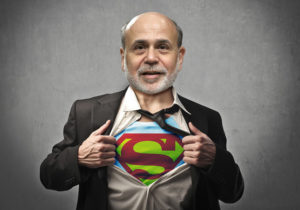Last week, we discussed causes of the Great Recession. Today, we look at how it was addressed.
The financial crisis was essentially a debt crisis. Mortgagees were unable to pay their mortgages, which turned into bad debt, which bankers, Fannie Mae and Freddie Mac leveraged to turn into even more bad debt. And the debt crisis spread globally.
So how did America and the rest of the world address the debt problem? With more debt.
Global debt, including sovereign, corporate and household debt, increased nearly 75% during the past decade. Globally, sovereign debt more than doubled, from $29 trillion to $60 trillion, while corporate debt increased 78% to $66 trillion, according to a report from McKinsey. The report also found that 40% of U.S. companies are rated a notch above “junk” or lower.
“This is what zero interest rates and quantitative easing have wrought — more debt and lower credit quality,” according to The Wall Street Journal.
The American Recovery and Reinvestment Act of 2009 was supposed to revitalize the economy with spending on “shovel ready” infrastructure projects, but of the $836 billion that was spent, $99 billion went to Medicaid, $64 billion to increased unemployment compensation and $48 billion on the Supplemental Nutrition Assistance Program (SNAP). These entitlements did nothing to stimulate the economy. Some of the projects funded were inefficient or potentially fraudulent; others benefited political donors.
Congress also approved the Troubled Asset Relief Program (TARP), a $700 billion bank bailout that also allocated funds to bail out General Motors.
Partisan Bickering
Regardless, when it came to addressing the financial crisis, according to The Wall Street Journal, “Congress, paralyzed by partisan bickering, failed. It barely managed to enact the triage of the Troubled Asset Recovery Program, authorizing the Treasury to purchase defaulted bonds. Then it spent years blaming and vilifying ‘Wall Street,’ only to restrict its critical market-making and liquidity-providing functions while leaving the credit-rating firms and their conflict-laden model untouched. Lawmakers achieved nothing else meaningful in the eight following years.”
The Federal Reserve Board, meanwhile, reversed the direction of interest rates with its quantitative easing (i.e., bond buying), which increased its portfolio from less than $1 trillion to nearly $4 trillion.
Following its zero interest rate policy (ZIRP), the Fed drove interest rates to just above zero percent and held them there until December 2015. The stock market soared, setting records, but the market boost was due to Fed manipulation, not healthy fundamentals. Housing prices began to recover, as low rates produced demand, but many homeowners remained “under water,” because their mortgages exceeded the value of their homes.
More Regulation
The recession ended in June 2009 and in 2010 Congress celebrated by passing the Dodd-Frank Wall Street Reform and Consumer Protection Act as well as the Affordable Care Act, the two lengthiest and most complex pieces of legislation ever signed into law.
The economy reacted by growing at a rate of about 2% for eight years, well below its average growth rate of 3.3%. Incomes still have not recovered to pre-recession levels, the federal debt is now $21.5 trillion and the Fed is just beginning to “normalize” its $4 trillion portfolio.
Today, the economy is growing rapidly, unemployment has dropped, personal income is rising and the bull market continues.
But banks that were “too big to fail” are bigger than ever, rating agencies are still rating, and Fannie Mae and Freddie Mac are more powerful than ever. The CRA also remains and the U.S. Treasury is seeking to modernize it — by adding performance incentives, so that banks will lend more to people who can’t afford to be homeowners.
How long will it be before we see another crisis?
